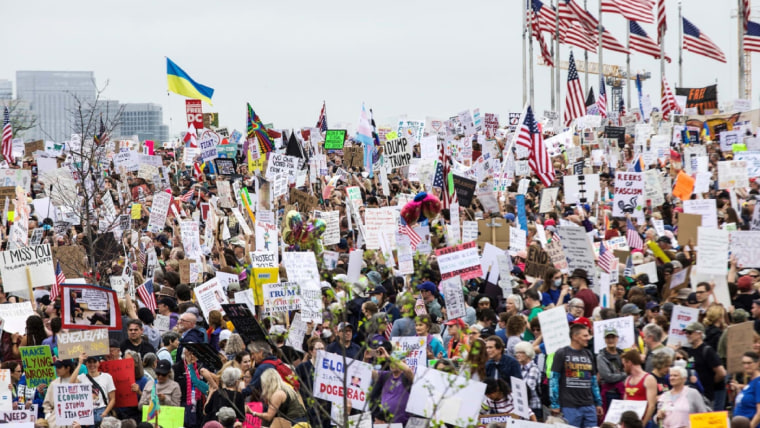The day after President Donald Trump was sworn into office for his first term, he was met with the largest single-day protest in American history. But the second time around, the protests surrounding Trump’s inauguration were comparably muted — they were a fraction of the size, and generated far less impact than the first round. The disparity seemed to capture the demoralized, depleted mood among Americans who opposed Trump and stared slack-jawed as he won the popular vote upon his third attempt at the White House.
Yet on Saturday, mass protests swept the nation, and it could mean that dissenting Americans are finding their voices again. At a time when Trump is moving aggressively to crack down on intellectual and political dissent at universities, last weekend’s protests represented a massive rebuke of the Trump administration — and suggested the left is regaining its footing, as it figures out how to fight back.
Registering dissent is an important democratic exercise.
Saturday’s “Hands Off!” rallies were backed by a large coalition of organizations that included civil rights groups, labor unions, climate groups, progressive activist outfits and left-wing groups like the Democratic Socialists of America. The organizers put forth three demands: “an end to the billionaire takeover and rampant corruption of the Trump administration”; “an end to slashing federal funds for Medicaid, Social Security, and other programs working people rely on”; and “an end to the attacks on immigrants, trans people, and other communities.”
The turnout was big: Over 1,000 “Hands Off” protests were planned across all 50 states, and organizers said turnout far exceeded the turnout of 500,000 RSVPs. There aren’t any independent estimates of national turnout, but dense, large crowds made their presence known in many cities. Per The New York Times:
On Fifth Avenue in Manhattan, the protest stretched for nearly 20 blocks. In Chicago, thousands flooded Daley Plaza and adjacent streets, while, in the nation’s capital, tens of thousands surrounded the Washington Monument. In Atlanta, the police estimated the crowd marching to the gold-domed statehouse at over 20,000.
In addition to the crowds of thousands — or tens of thousands — who showed up in cities and towns across the nation, protests also took place abroad in cities including London, Paris and Berlin.
Like all mass protests, the messages conveyed at these ones were diverse and sprawled beyond the overarching themes of the organizers. Protest signs expressed concern about free speech at a time when Trump is trying to quash it by bullying universities and attempting to deport legal immigrants who express pro-Palestinian speech. There were objections to Trump’s global economy-destabilizing tariff regime. In Washington, D.C., a rally for Gaza, in which protesters marched to the Immigration and Customs Enforcement headquarters, took place adjacent to the main “Hands Off” rally. And a lot of signs framed Trump and billionaire Elon Musk as posing a fascist threat to the country.

The broad scope of the protests mirrors the broad scope of Trump’s assault on our republic — and underscores how big of a tent the anti-Trump coalition is going to need to be to effectively resist Trump’s dismantling of the administrative state, social services and democratic institutions.
To be sure, though it’s been on a smaller scale and less noticed, there actually has been a lot of protest activity in the first few months of Trump’s second administration. Indivisible, a liberal grassroots network, was effective in encouraging outraged citizens to go to town halls to make noise and hold Republicans accountable — so much so that the National Republican Congressional Committee advised GOP lawmakers to stop attending town halls rather than face their constituents’ wrath. Musk’s Tesla has been the object of boycotts and protests that appear to be hurting its bottom line. Anti-DOGE protests have taken place across the country for months. And while the Democratic Party leadership has largely shown itself to be feckless and is increasingly losing the trust of its members, Sen. Bernie Sanders, I-Vt., has been drawing huge crowds in swing states across the U.S. with his “Fighting Oligarchy” Tour.

It can be easy to overestimate the significance of a single protest, even a huge one. One-off protests can be forgotten rather quickly in an era where the news cycle moves at an unfathomable speed. And it’s relatively easy to get people to object to something; it’s far harder to get them to organize around a widely desired alternative.
Still, registering dissent is an important democratic exercise, and reports of older first-time protesters coming out to say “no” to Trump are positive signs. As the republic teeters on the edge of myriad crises, the left is exhausted and afraid. But on Saturday it reminded us it’s still here, and it’s not going to go quietly into the night.

